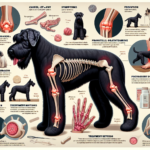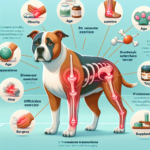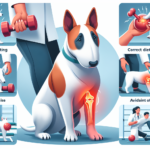Black Russian Terrier Joint Pain: Causes, Symptoms, Prevention, and Treatment

Introduction
The Black Russian Terrier, often referred to as the “Black Pearl of Russia,” is a robust and versatile breed known for its strength, intelligence, and protective nature. Developed in the mid-20th century by the Soviet Union, this breed was initially created for military and working purposes. The Black Russian Terrier is a large, powerful dog with a distinctive black coat and a confident demeanor. Despite its intimidating appearance, it is known for being loyal and affectionate with its family.
Like many large breeds, the Black Russian Terrier is prone to certain health issues, with joint pain being a significant concern. Joint health is crucial for this breed due to its size, weight, and active lifestyle. Understanding the causes, symptoms, prevention, and treatment of joint pain in Black Russian Terriers is essential for ensuring their well-being and quality of life.
Breed-Specific Joint Pain Risks
Genetic Predisposition
Black Russian Terriers are genetically predisposed to several joint-related issues, including hip dysplasia, elbow dysplasia, and arthritis. Hip dysplasia is a condition where the hip joint does not fit properly into the hip socket, leading to pain and mobility issues. Elbow dysplasia involves abnormal development of the elbow joint, causing lameness and discomfort. Arthritis, a degenerative joint disease, can also affect this breed, leading to chronic pain and stiffness.
Age-Related Risks
As Black Russian Terriers age, the risk of developing joint pain increases. While joint issues can occur at any age, they are more common in older dogs. Owners should be vigilant about monitoring their dog’s joint health as they approach middle age, typically around 5-7 years old. Early detection and intervention can help manage and mitigate the impact of joint pain.
Activity Level and Joint Stress
Black Russian Terriers are known for their high energy levels and need for regular exercise. While physical activity is essential for their overall health, excessive or inappropriate exercise can put undue stress on their joints. Activities that involve jumping, running on hard surfaces, or sudden changes in direction can exacerbate joint issues. It’s important to balance their exercise routine to promote joint health without causing additional strain.
Common Symptoms of Joint Pain in Black Russian Terriers
General Symptoms
- Limping or favoring one leg
- Stiffness, especially after rest or exercise
- Reluctance to move, jump, or climb stairs
- Decreased activity or interest in play
- Swelling or heat around the joints
- Whining or showing signs of discomfort when touched
Breed-Specific Symptoms
In Black Russian Terriers, joint pain may manifest more prominently due to their size and weight. Owners may notice a significant decrease in their dog’s willingness to engage in physical activities they once enjoyed. Additionally, the breed’s thick coat can sometimes mask swelling, making it essential to pay close attention to subtle changes in behavior and movement.
When to Consult a Vet
If you observe any of the above symptoms in your Black Russian Terrier, it’s crucial to consult a veterinarian promptly. Early diagnosis and treatment can prevent further deterioration and improve your dog’s quality of life. Regular veterinary check-ups are also essential for monitoring joint health and catching any issues early.
Preventive Measures for Joint Health
Exercise Recommendations
To maintain joint health in Black Russian Terriers, it’s important to provide regular, low-impact exercise. Activities such as walking, swimming, and controlled play are excellent options. Avoid high-impact exercises like jumping or running on hard surfaces, which can exacerbate joint stress. Consistent, moderate exercise helps keep the joints flexible and muscles strong, supporting overall joint health.
Dietary Suggestions
A balanced diet rich in essential nutrients is vital for joint health. Consider incorporating foods or supplements that contain glucosamine, chondroitin, and omega-3 fatty acids, which support joint function and reduce inflammation. High-quality commercial dog foods formulated for large breeds often include these nutrients. Consult your veterinarian for specific dietary recommendations tailored to your dog’s needs.
Weight Management
Maintaining a healthy weight is crucial for reducing joint stress in Black Russian Terriers. Excess weight puts additional pressure on the joints, exacerbating pain and mobility issues. Monitor your dog’s weight regularly and adjust their diet and exercise routine as needed to keep them at an optimal weight. Your veterinarian can provide guidance on appropriate weight ranges and portion sizes.
Early Screening and Monitoring
Regular veterinary check-ups and early screening for joint issues are essential for Black Russian Terriers. X-rays and other diagnostic tools can help identify joint problems before they become severe. Early intervention, including lifestyle adjustments and medical treatments, can significantly improve outcomes for dogs with joint issues.
Treatment Options for Joint Pain
Non-Surgical Treatments
Non-surgical treatments for joint pain in Black Russian Terriers include medications, physical therapy, and lifestyle adjustments. Anti-inflammatory drugs and pain relievers can help manage symptoms and improve mobility. Physical therapy, including exercises and massage, can strengthen muscles and support joint function. Lifestyle adjustments, such as providing a comfortable bed and avoiding strenuous activities, can also alleviate joint pain.
Surgical Options
In severe cases, surgical intervention may be necessary to address joint pain in Black Russian Terriers. Common surgical options include hip replacement, arthroscopy, and joint fusion. These procedures can provide significant relief and improve mobility, but they come with risks and require careful post-operative care. Consult with a veterinary orthopedic specialist to determine the best course of action for your dog.
Alternative Therapies
Alternative therapies such as acupuncture, hydrotherapy, and chiropractic care can also benefit Black Russian Terriers with joint pain. Acupuncture involves inserting fine needles into specific points on the body to relieve pain and promote healing. Hydrotherapy, or water therapy, provides low-impact exercise that supports joint health. Chiropractic care focuses on aligning the spine and joints to improve overall function. These therapies can be used in conjunction with traditional treatments for a holistic approach to joint health.
Lifestyle and Management Tips
Daily Care Routine
A consistent daily care routine can help manage and alleviate joint pain in Black Russian Terriers. Start with a gentle morning walk to loosen stiff joints, followed by a balanced meal with joint-supporting supplements. Incorporate short, low-impact play sessions throughout the day to keep your dog active without overexerting their joints. End the day with a relaxing massage to soothe any discomfort.
Modifying the Home Environment
Making your home more comfortable for a dog with joint pain can significantly improve their quality of life. Consider adding ramps to help them navigate stairs and get onto furniture without jumping. Provide an orthopedic bed that offers support and cushioning for their joints. Ensure that food and water bowls are at a comfortable height to reduce strain on their neck and joints.
Long-Term Management
Long-term management of joint pain in Black Russian Terriers involves a combination of regular veterinary care, appropriate exercise, a balanced diet, and a supportive home environment. Consistent monitoring and early intervention can help manage symptoms and prevent further deterioration. By taking a proactive approach to joint health, you can ensure your dog remains active and happy throughout their life.
FAQs About Black Russian Terriers and Joint Pain
What are the early signs of joint pain in Black Russian Terriers?
Early signs of joint pain include limping, stiffness, reluctance to move, and decreased activity levels. If you notice any of these symptoms, consult your veterinarian for a thorough evaluation.
Can joint pain in Black Russian Terriers be prevented?
While genetic predisposition cannot be entirely prevented, you can take steps to reduce the risk and manage symptoms. Regular exercise, a balanced diet, weight management, and early screening are essential preventive measures.
Are there specific exercises that are better for Black Russian Terriers with joint pain?
Low-impact exercises such as walking, swimming, and controlled play are ideal for Black Russian Terriers with joint pain. Avoid high-impact activities that can exacerbate joint stress.
What dietary supplements are beneficial for joint health in Black Russian Terriers?
Supplements containing glucosamine, chondroitin, and omega-3 fatty acids are beneficial for joint health. Consult your veterinarian for specific recommendations based on your dog’s needs.
When should I consider surgical options for my dog’s joint pain?
Surgical options should be considered when non-surgical treatments are no longer effective, and your dog’s quality of life is significantly impacted. Consult with a veterinary orthopedic specialist to determine the best course of action.
Conclusion
Joint pain is a common concern for Black Russian Terriers, but with proper care and attention, it can be managed effectively. Understanding the causes, symptoms, prevention, and treatment options is essential for ensuring your dog’s well-being. By taking proactive measures such as regular exercise, a balanced diet, weight management, and early screening, you can support your dog’s joint health and enhance their quality of life. Always consult your veterinarian for personalized advice and treatment options to keep your Black Russian Terrier happy and active.




